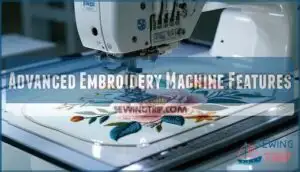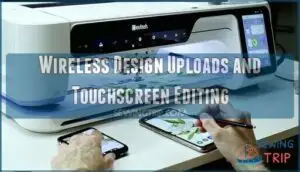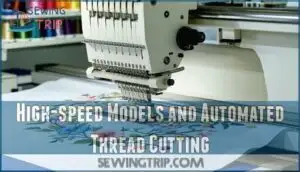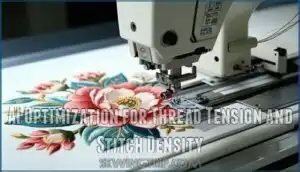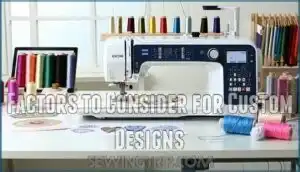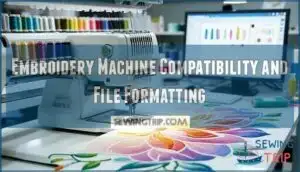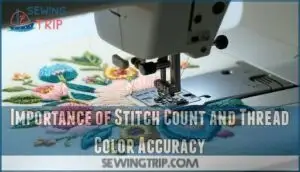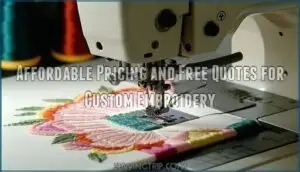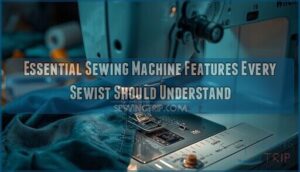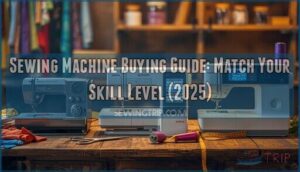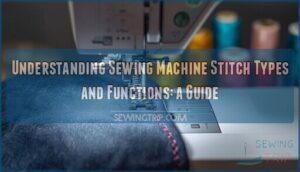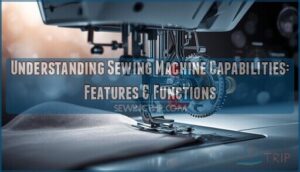This site is supported by our readers. We may earn a commission, at no cost to you, if you purchase through links.

Look for machines with large hoops, multiple built-in designs, and compatibility with various file formats like PES, DST, and JEF.
The Brother SE700 and Ricoma single-head models lead the pack for their reliability and precision.
Consider your skill level too – beginners benefit from user-friendly touchscreens and automatic threading, while advanced crafters need high-speed stitching and professional-grade tension control.
Your budget also plays a role, with quality options ranging from $300 to several thousand dollars.
The right machine transforms your creative visions into professional-quality pieces that’ll have everyone asking where you learned such wizardry.
Table Of Contents
- Key Takeaways
- Custom Design Basics
- Digitizing Services
- Top 9 Embroidery Machines
- 1. Brother SE700 Sewing Embroidery Machine
- 2. EOC05 Embroidery Machine Large Hoop
- 3. Smartstitch 15 Needle Embroidery Machine
- 4. Brother PE545 Wireless Embroidery Machine
- 5. POOLIN Embroidery Machine Large Hoop Beginner
- 6. Brother SE1900 Sewing and Embroidery Machine
- 7. Brother LB5000 Sewing Embroidery Machine Combo
- 8. Brother SE725 Sewing Embroidery Machine Renewed
- 9. Ricoma Single Head Embroidery Machine
- Embroidery Machine Technology
- Choosing Right Embroidery Machine
- Frequently Asked Questions (FAQs)
- Conclusion
Key Takeaways
- You’ll want a machine with large hoops and multiple file format compatibility – Look for models that handle PES, DST, and JEF files with embroidery areas of at least 4" x 4" to accommodate most custom designs without constant re-hooping.
- Match your skill level to the machine’s features – Beginners should prioritize user-friendly touchscreens and automatic threading, while experienced users can leverage high-speed stitching and professional tension controls for complex projects.
- Budget between $300-$5,000 based on your needs – Entry-level machines like the Brother SE700 offer solid performance for hobbyists, while commercial-grade models like Ricoma’s 15-needle machines handle high-volume business operations.
- Proper file formatting and digitizing services are crucial – You’ll need correctly formatted design files with proper stitch counts and thread specifications, or access to professional digitizing services to convert your artwork into machine-readable embroidery files.
Custom Design Basics
Creating custom embroidery designs starts with understanding the technical requirements that’ll make or break your project.
You’ll need properly formatted files, correct thread specifications, and designs that fit within your machine’s size limitations to achieve professional results.
This involves considering the technical requirements to ensure your project turns out as expected.
Embroidery File and Design Requirements
When starting your embroidery journey, you’ll need properly formatted design files that match your machine’s specifications.
DST format works across most commercial machines, while PES supports intricate designs with up to 127 Thread Colors.
Size Limitations vary by application—shirts max at 4"×4", caps at 2.25" height.
File Compatibility depends on your machine brand, so check Design Specifications before digitizing.
Understanding embroidery file formats is essential for achieving the desired results.
Importance of Proper File Formatting
Once you’ve got your design specifications ready, proper file formatting becomes your gateway to flawless embroidery results.
File Compatibility determines whether your embroidery machine can read your design file without hiccups.
Design file formatting affects Stitch Accuracy and Design Integrity directly.
Machine Performance relies on correct embroidery file types like Tajima formats.
Proper design file specifications prevent costly mistakes and guarantee Error Reduction during production runs.
Many machines support universal DST files for broad compatibility.
Color Thread Specifications and Design Size Limits
When planning your custom embroidery project, Thread Color Accuracy becomes vital for professional results.
Design Size Adherence guarantees your artwork fits within embroidery dimensions, typically 2.3″ height by 4.3″ width for caps.
Consider Cap Panel Limitations when selecting design placement, and ensure File Format Compatibility with your machine to prevent costly mistakes.
Include precise Digitizing Design Details, color selection requirements, and embroidery thread specifications for flawless execution.
Digitizing Services
You’ll need professional digitizing services to convert your artwork into embroidery machine files that produce crisp, clean stitching.
First-time customers can work with trained staff who’ll digitize designs based on complexity and size, ensuring your custom embroidery translates perfectly from concept to finished product.
First-time Customer Digitizing Options
As a first-time customer, you’ll discover digitizing consultation makes custom designs accessible.
Submit your artwork via fax or email with contact information for professional evaluation. Fee structure varies based on design complexity and stitch count requirements.
Staff creates digitized art files ensuring file compatibility with your embroidery machine. Understanding digitizing service costs is essential for budgeting your project.
Design file creation transforms your vision into embroidery digitizing format for seamless custom digitizing results.
Custom Digitizing Fees and Complexity Factors
Your design digitization costs depend on several key factors that directly impact pricing.
Design complexity drives costs higher when intricate details require precise stitch density adjustments and multiple thread changes.
Material type affects file conversion requirements, with specialized fabrics needing custom digitizing approaches.
Rush orders typically increase fees due to expedited processing.
Most digitizers charge based on design file complexity rather than simple stitch counts, considering embroidery digitizing expertise required for quality results.
The final price can also depend on the design’s stitch count, which is a crucial factor in determining the overall cost of digitization, reflecting the need for quality results.
Highly Trained Staff for Custom Digitizing
Expert digitization teams transform complex designs into flawless embroidery files through specialized training.
Their digitizer skillset guarantees design consultation addresses your unique needs while maintaining digitizing accuracy across intricate patterns.
Professional staff training covers:
- Complex designs – Multi-layered logos requiring precise stitch placement
- Design consultation – Understanding fabric types and thread limitations
- Custom digitizing – Optimizing design complexity for smooth machine operation
These specialists analyze your artwork’s intricacies, determining ideal stitch counts and thread paths.
Their expertise guarantees your design digitization produces professional results every time.
Top 9 Embroidery Machines
You’ll find machines that balance power with precision, from beginner-friendly options to professional-grade models.
That handle complex custom designs, each machine offers unique features like wireless connectivity, large embroidery hoops, and multi-needle capabilities.
That’ll transform your creative vision into stunning embroidered pieces.
1. Brother SE700 Sewing Embroidery Machine
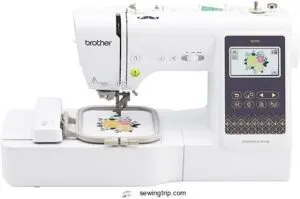
You’ll find the Brother SE700 combines sewing and embroidery capabilities in one compact machine that’s perfect for custom projects.
This wireless-enabled powerhouse features a 4" x 4" embroidery field with 135 built-in designs and 10 fonts.
You can transfer custom patterns wirelessly using the Artspira app or Design Database Transfer software, and the 3.7" color touchscreen makes editing designs simple.
Automatic threading saves time, and at 710 stitches per minute, it handles detailed work efficiently, with users praising its beginner-friendly interface and seamless switching between functions.
Best For: Hobbyists and beginners looking for an easy-to-use sewing and embroidery machine with wireless design transfer and creative flexibility.
- Combines sewing and embroidery in one compact, beginner-friendly machine
- Wireless design transfer via Artspira app or PC software
- 135 built-in designs and 10 fonts with on-screen editing on a color touchscreen
- 4" x 4" embroidery area may be too small for larger projects
- Some users reported connectivity issues with mobile apps
- Mixed reviews on customer service and difficulty with warranty claims
2. EOC05 Embroidery Machine Large Hoop
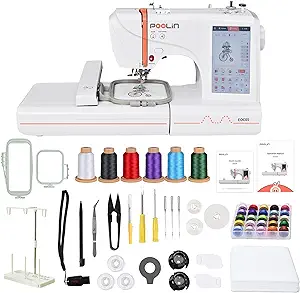
Featuring a generous 4" x 9.25" embroidery area, the EOC05 opens doors to larger custom designs that smaller machines can’t handle.
You’ll appreciate its 7-inch touchscreen that makes pattern selection feel like using your smartphone.
The machine includes 96 built-in designs and supports DST/DSB file imports via USB for your custom creations.
At 650-700 stitches per minute, it delivers solid performance for home embroiderers, with automatic needle threading and thread trimming features that save time on every project.
Best For: Beginners and home users who want easy setup, built-in designs, and the ability to handle larger embroidery projects.
- Large 4" x 9.25" embroidery area supports bigger, more complex designs than entry-level models.
- Intuitive 7-inch touchscreen and automatic threading make operation easy, even for first-timers.
- Supports custom pattern imports via USB and includes a wide range of built-in designs and fonts.
- No dedicated sewing or hat/cap embroidery unit; hats must be placed flat in the frame.
- Single-needle design means color changes must be done manually, slowing multicolor projects.
- Fixed embroidery area limits oversized or commercial-scale projects.
3. Smartstitch 15 Needle Embroidery Machine
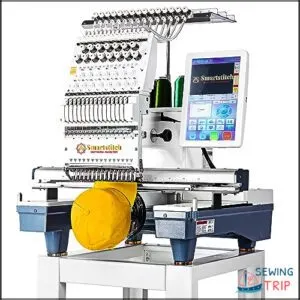
This commercial-grade powerhouse transforms your embroidery dreams into reality with fifteen needles working in perfect harmony.
Looking at the paragraph about the Smartstitch 15 Needle Embroidery Machine, here’s a matching blockquote:
Fifteen needles dancing together at lightning speed—your embroidery business revolution starts here.
You’ll achieve professional results at lightning speed—1200 stitches per minute—while the generous 14"x20" workspace accommodates everything from intricate logos to oversized jacket designs.
The intuitive 12-inch touchscreen puts complete control at your fingertips, letting you edit designs on the fly.
At $5,399, it’s your gateway to serious embroidery business success.
Best For: Small businesses, startups, and hobbyists ready to take on high-volume embroidery projects with a professional finish.
- Fast, efficient production with 15 needles and 1200 stitches per minute.
- Large 14"x20" embroidery area fits oversized projects, jackets, and caps.
- User-friendly 12" touchscreen and strong community support make learning accessible.
- Steep learning curve for beginners, especially threading and file prep.
- Requires significant upfront investment around $5,399.
- Needs careful unpacking and storage of packaging for potential returns.
4. Brother PE545 Wireless Embroidery Machine
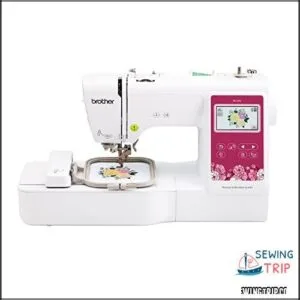
The Brother PE545 stands out as your gateway to wireless embroidery freedom.
You’ll love transferring designs directly from your phone or computer without fumbling with USB drives.
Its 4" x 4" embroidery area handles most personal projects beautifully, while the 3.7" touchscreen makes editing designs feel like playing with your favorite app.
With 135 built-in designs and the free Artspira app, you’re getting serious bang for your buck at around $460, which is a great value for the embroidery freedom it offers.
Best For: Beginners, hobbyists, and small business owners looking for an easy-to-use embroidery machine with wireless design transfer.
- Wireless LAN lets you send designs from your phone or computer without hassle.
- Simple touchscreen controls and built-in tutorials make setup and editing easy for anyone.
- Includes 135 built-in designs and 10 fonts for lots of creative possibilities right out of the box.
- 4" x 4" embroidery area limits the size of projects you can tackle.
- Occasional issues with thread tension, needle breakage, and software compatibility.
- Not suited for traditional sewing or large commercial projects; embroidery-only functionality.
5. POOLIN Embroidery Machine Large Hoop Beginner
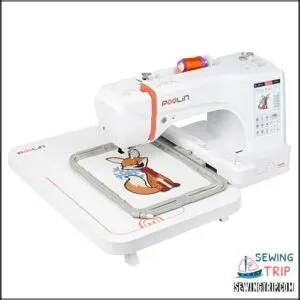
POOLIN’s EOC05 embroidery machine delivers impressive versatility with its 4" x 9.25" embroidery area, perfect for tackling larger custom designs.
You’ll appreciate the beginner-friendly 7-inch touchscreen and pre-threaded setup that gets you stitching immediately.
With 650-700 stitches per minute, automatic threading, and extensive support including one-on-one engineer assistance, this affordable machine removes the intimidation factor from custom embroidery while delivering professional results.
Best For: Beginners and home users who want a straightforward, affordable embroidery machine with a large hoop for personalized projects.
- Large 4" x 9.25" embroidery area offers flexibility for bigger or custom designs.
- Beginner-friendly with an intuitive 7-inch touchscreen and pre-threaded setup.
- Strong support network with videos, one-on-one engineer help, and active online community.
- Single-needle design requires manual thread changes for multi-color patterns.
- Some users report a learning curve with custom design digitizing.
- Occasional delivery handling issues, though usually resolved with support.
6. Brother SE1900 Sewing and Embroidery Machine
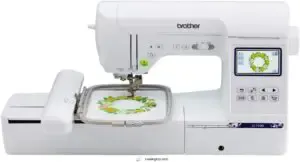
When you need embroidery precision that goes beyond basic features, the SE1900 delivers professional-grade results with 138 built-in designs and 11 fonts.
You’ll appreciate the 5" x 7" embroidery field that handles larger custom projects while maintaining thread tension accuracy.
The 3.2" color touchscreen lets you preview designs in actual thread colors before stitching.
With 240 sewing stitches included, you can seamlessly move between embroidery and garment construction.
The automatic thread cutter and low bobbin alert keep your workflow smooth during complex multi-color designs.
Best For: Hobbyists and home-based crafters who want a versatile machine for both advanced embroidery and sewing projects.
- Requires separate embroidery software for advanced custom design editing.
- Thread changes are frequent due to single-needle operation.
- Extension table and magnetic hoops for larger projects must be purchased separately.
- Large 5" x 7" embroidery area accommodates bigger designs and fewer re-hoopings.
- 3.2" full-color touchscreen provides intuitive design editing and real-time previews.
- 138 built-in embroidery designs, 11 fonts, and 240 sewing stitches offer extensive creative options.
7. Brother LB5000 Sewing Embroidery Machine Combo
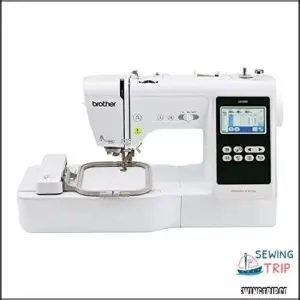
Precision meets versatility in the Brother LB5000, a machine that transforms your creative vision into stitched reality.
You’ll discover 103 built-in sewing stitches and 80 embroidery designs that handle everything from delicate monogramming to bold custom graphics.
The 4" x 4" embroidery field accommodates most personal projects, while USB connectivity lets you import.pes files seamlessly.
Its automatic needle threader and jam-resistant bobbin system eliminate common frustrations, making complex multi-color designs manageable for beginners and experienced crafters alike.
Brother also provides access to the Artspira mobile app for wireless design transfers.
Best For: Home crafters and small business owners who want an easy-to-use, all-in-one sewing and embroidery solution with custom design import.
- Versatile machine for sewing, embroidery, and quilting with easy USB custom design import.
- Beginner-friendly touchscreen controls, automatic needle threader, and jam-resistant bobbin.
- Includes 80 embroidery designs, 9 fonts, and 103 sewing stitches for a variety of creative projects.
- Limited 4" x 4" embroidery area restricts design size for larger projects.
- Requires manual thread changes and careful setup for multi-color embroidery.
- Not suitable for heavy commercial use or advanced professionals needing larger hoops.
8. Brother SE725 Sewing Embroidery Machine Renewed
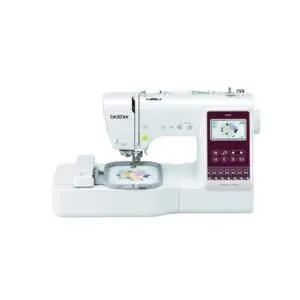
This refurbished powerhouse delivers wireless connectivity that’ll revolutionize your custom design workflow.
You get 135 built-in embroidery designs, wireless LAN transfers, and the innovative Artspira app for creating patterns on your phone.
The 4" x 4" embroidery area handles most custom projects perfectly.
While some users report setup hiccups with refurbished units, the 710 stitches per minute speed and automatic thread cutter make it worth considering for budget-conscious creators.
Best For: Hobbyists and small business owners who want affordable sewing and embroidery with wireless custom designs.
- Refurbished models may have reliability issues, especially during setup.
- Limited 90-day warranty for refurbished units.
- 4" x 4" embroidery area may be too small for larger projects.
- Wireless LAN and Artspira App make design transfer and custom creation simple.
- 135 built-in embroidery designs and 103 sewing stitches offer wide creative variety.
- Fast setup with automatic needle threading and thread cutter speeds up projects.
9. Ricoma Single Head Embroidery Machine
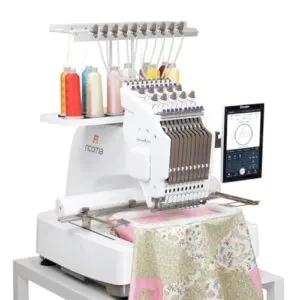
For serious embroidery businesses, Ricoma’s MT-1501 delivers commercial-grade performance with fifteen needles and lightning-fast 1,200 stitches per minute.
You’ll handle large orders effortlessly with its massive 19.7" x 14.2" embroidery area and 270° cap system.
The machine stores 200 designs and supports DST files for seamless workflow. At $12,995, it’s built for continuous operation with thorough training and five-year warranty backing your investment.
Best For: Growing businesses and professional embroiderers who need high-speed, high-volume production on a wide range of apparel and accessories.
- Handles large, complex, multi-color projects quickly and efficiently with 15 needles and speeds up to 1,200 SPM.
- Extra-large embroidery area and advanced cap system support a variety of items, from jackets to structured hats.
- Robust warranty, 24/7 support, and training included for a smoother learning curve and long-term reliability.
- Initial price point ($12,995) may be challenging for hobbyists or small startups.
- Proper setup and operator experience are critical to avoid thread breaks or errors, particularly on hats and thick fabrics.
- Machine size and weight require adequate workspace and may not suit every home-based operation.
Embroidery Machine Technology
Today’s embroidery machines pack serious tech power that’ll transform how you create custom designs.
You’re looking at wireless uploads, AI optimization, and lightning-fast stitching speeds that make professional-quality embroidery accessible right from your workspace.
Advanced Embroidery Machine Features
Today’s advanced embroidery machines pack cutting-edge features that transform your creative workflow.
AI Optimization automatically adjusts thread tension and stitch density, while High-Speed Stitching reaches 800 stitches per minute.
Automated Cutting eliminates manual thread trimming between colors.
Touchscreen Editing lets you modify embroidery designs directly on the machine, making custom designs more precise and efficient than ever before with AI Optimization and Automated Cutting.
Wireless Design Uploads and Touchscreen Editing
Gone are the days of fumbling with USB cables—modern embroidery machines embrace wireless transfer technology.
You’ll connect your machine to Wi-Fi networks, uploading designs directly from your smartphone or tablet.
Touchscreen accuracy transforms how you edit patterns, letting you resize and position elements with precise finger taps.
Design software syncs seamlessly with mobile editing apps, while cloud storage keeps your custom designs accessible anywhere you create, utilizing modern embroidery machines.
High-speed Models and Automated Thread Cutting
Today’s high-speed embroidery machines revolutionize custom designs with lightning-fast stitching and automated thread cutting.
These powerhouses achieve 800 stitches per minute while maintaining precision. Your embroidery workflow becomes streamlined through automation benefits that reduce manual intervention and boost production volume efficiency.
One such benefit is the automatic thread cutting feature, which saves time and guarantees clean finishes.
Key advantages of high-speed automated models:
- Speed vs. Quality balance – Modern machines maintain stitch accuracy even at maximum speeds
- Thread Cutting Efficiency – Automatic trimming eliminates manual snipping between color changes
- Production Volume capacity – Handle large orders without sacrificing embroidery file conversion quality
- Reduced Maintenance Needs – Self-monitoring systems prevent thread jams and needle breaks
- Enhanced design file stitch instructions – Precise automation follows complex patterns flawlessly
AI Optimization for Thread Tension and Stitch Density
With AI precision monitoring your machine, thread tension adjusts automatically in 0.05 seconds per stitch.
Advanced fabric analysis optimizes stitch quality across materials, preventing puckering and breaks.
Automation benefits include reduced waste and seamless design customization.
Your machine embroidery designs benefit from intelligent stitch instructions that adapt embroidery techniques without manual intervention, delivering professional results.
Choosing Right Embroidery Machine
You’ll need to match your embroidery machine’s capabilities with your specific custom design requirements to guarantee professional results.
Consider factors like hoop size, file compatibility, stitch count limits, and thread color accuracy when selecting the right machine for your projects.
Factors to Consider for Custom Designs
When choosing an embroidery machine for custom work, consider Design Complexity and your Project Goals first.
Complex embroidery designs need machines with larger hoops and advanced stitch types.
Your Fabric Choice matters too—delicate materials require precise tension control.
Think about your Color Palette needs and thread capacity. Custom digitizing capabilities and embroidery file compatibility guarantee your machine embroidery designs translate perfectly from concept to finished piece.
Embroidery Machine Compatibility and File Formatting
Why worry about compatibility when your machine can’t read your design? File type matters most – Brother machines need PES files, while Janome requires JEF format.
Tajima files work universally but lack color data. Check your machine’s design size limits and thread specs before starting.
Proper embroidery file formatting guidelines prevent costly mistakes and guarantee seamless embroidery production. Many crafters source PES embroidery designs online.
Importance of Stitch Count and Thread Color Accuracy
Once your embroidery machine reads a file, stitch count and thread color accuracy become your best friends.
High stitch density adds detail but can bump up cost implications.
Thread quality and color matching keep designs sharp and true to your brand.
Always double-check design color requirements, design size limits, and stitch count in your file—mistakes here can unravel your masterpiece.
Affordable Pricing and Free Quotes for Custom Embroidery
Smart budgeting transforms your custom embroidery dreams into reality.
Transform your wallet-friendly embroidery vision into stitched reality with smart budgeting strategies.
Most shops offer free quotes that break down embroidery costs by design complexity and stitch count.
You’ll discover volume discounts for bulk orders, making budget embroidery achievable.
Don’t hesitate with price negotiation—many providers adjust affordable pricing based on project scope, ensuring custom design embroidery fits your wallet perfectly.
Frequently Asked Questions (FAQs)
Can embroidery machines do custom designs?
Modern machines achieve 800 stitches per minute, making custom designs effortless.
You’ll create personalized logos, artwork, and unique patterns using built-in software or uploaded files.
Today’s embroidery technology transforms your creative vision into stunning, professional results.
Which embroidery software is best for custom designs?
Popular choices include Wilcom’s Hatch for professional results, Brother’s PE-Design for user-friendly interface, and Embird for budget-conscious creators.
You’ll find these programs offer excellent digitizing tools, built-in fonts, and design editing capabilities for your custom projects.
How do I digitize my design for embroidery?
Practice makes perfect when you’re digitizing designs for embroidery machines.
You’ll convert artwork into stitch files using specialized software that maps thread paths, stitch types, and densities for your specific fabric and design requirements, which involves complete concepts and understanding of digitizing designs.
How to turn designs into embroidery?
You’ll convert your artwork into embroidery by digitizing it through specialized software that creates stitch patterns.
Professional digitizing services can transform your design into machine-readable files like Tajima format for precise stitching.
What maintenance schedule keeps embroidery machines running?
Your embroidery machine’s thread tension becomes a finicky monster without regular care, demanding daily cleaning, weekly oiling, and monthly deep maintenance checks.
Clean bobbin areas, replace needles frequently, and schedule professional servicing quarterly to prevent costly breakdowns.
How do you troubleshoot thread breaking issues?
Check your thread tension first—loose tension causes breaks.
Make certain you’re using quality thread that matches your needle size.
Clean lint from the tension discs, rethread completely, and verify your needle isn’t bent or dull, to ensure proper functioning.
Which fabric types work best with machines?
Looking at fabric like a map, cotton provides the sturdy highways while polyester offers smooth expressways for your needle’s journey.
You’ll find cotton, denim, canvas, and poly-cotton blends grip threads beautifully, creating crisp, professional results every time.
Whats the learning curve for beginners?
You’ll find basic stitching takes just a few hours to grasp, but mastering tension, design placement, and fabric handling requires several weeks of practice.
How much workspace do these machines require?
Picture your dining table transformed into a creative command center.
Most embroidery machines need roughly a 3×3 foot area – enough room for the machine, fabric hoops, and thread spools.
You’ll want clear space around all sides for easy access.
Conclusion
Congratulations on mastering the telegraph of modern crafting – your embroidery machine for custom designs will revolutionize your creative projects.
You’ve discovered the essential features that separate amateur attempts from professional masterpieces.
Remember, the perfect machine balances your skill level, budget, and project requirements.
Whether you choose the reliable Brother SE700 or invest in a high-end Ricoma model, you’re equipped with knowledge to make an informed decision.
Your custom embroidery journey starts now – transform those brilliant ideas into stunning, personalized creations that showcase your unique artistic vision, and enjoy the process of bringing your creative projects to life with your embroidery machine.
- https://www.goodhousekeeping.com/home-products/g37220559/best-embroidery-machines/
- https://www.reddit.com/r/Machine_Embroidery/comments/oeoguu/machine_recs_for_custom_designs/
- https://www.precedenceresearch.com/embroidery-machine-market
- https://insights.made-in-china.com/3-Exciting-2025-Trends-in-Industrial-Embroidery-Machines-to-Revolutionize-Your-Production-Line_jfztYeIlvniH.html
- https://www.transparencymarketresearch.com/computerized-sewing-and-embroidery-machine-market.html


